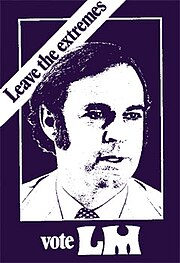Liberal Movement | |
|---|---|
 | |
| Historic leaders | Steele Hall |
| Founded | 21 March 1972 (as faction of the LCL) 2 April 1973 (as political party) |
| Dissolved | May 1976 |
| Split from | Liberal and Country League |
| Merged into | Liberal Party of Australia |
| Succeeded by | New Liberal Movement |
| Ideology | Social liberalism (Australian) Progressivism |
| Political position | Centre |
| This article is part of a series on |
| Liberalism in Australia |
|---|
 |
The Liberal Movement (LM) was a South Australian political party which existed from 1973 to 1976, and was a forerunner to the Australian Democrats.
The LM was initially organised in 1972 by former premier Steele Hall, as a progressive liberal group in the Liberal and Country League (LCL), in response to a perceived resistance to reform within the LCL. When tensions heightened between the LCL's conservative wing and the LM after the March 1973 state election, some of the members split from the LCL, forming a new party on 2 April 1973.
While still part of the LCL, the LM had eleven state parliamentarians. On its own, it was reduced to three parliamentarians − Hall and Robin Millhouse in the lower house and Martin Cameron in the upper house. At the 1974 federal election Hall won a Senate seat and David Boundy retained his South Australia seat for the LM. At the 1975 state election, Millhouse and Boundy retained their seats, while John Carnie won a second seat and Cameron retained his seat in the upper house, bringing the party to a peak of five parliamentarians.
However, the LCL and LM parties narrowly failed to dislodge the incumbent Dunstan Labor government at the 1975 state election. That result, together with internal weaknesses, led in 1976 to the LM's being re-absorbed into the LCL, which by then had become the South Australian Division of the Liberal Party of Australia. The Liberal Party also lost the 1977 state election, but succeeded in winning government at the 1979 state election.
A segment of the LM, led by former state attorney-general Robin Millhouse, did not rejoin the Liberals, but instead formed a new party—the New LM. This party, combined with the Australia Party—under the invited leadership of Don Chipp—formed the nucleus of the Australian Democrats which aspired to a balance of power in the federal Senate and up to four state upper houses for three decades. The LM and its successor parties gave voice to what is termed "small-l liberalism" in Australia.
© MMXXIII Rich X Search. We shall prevail. All rights reserved. Rich X Search
